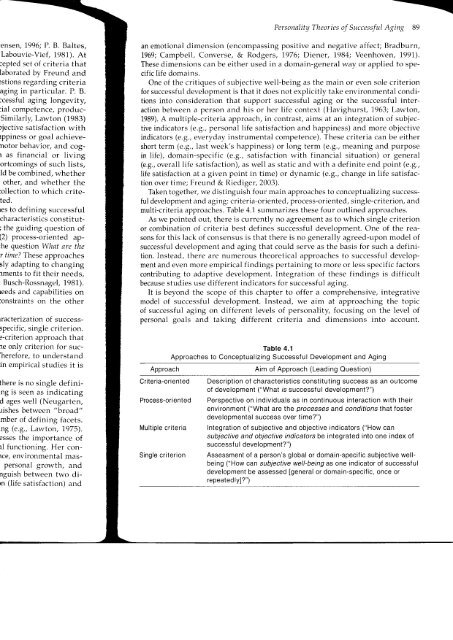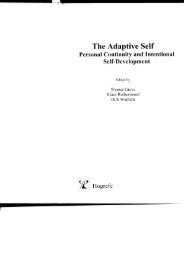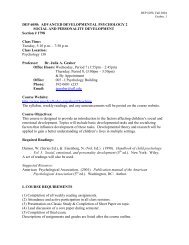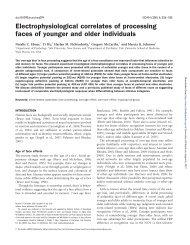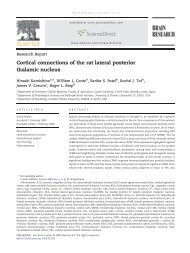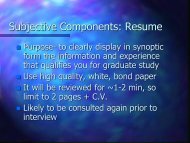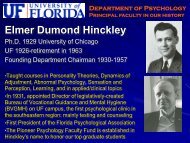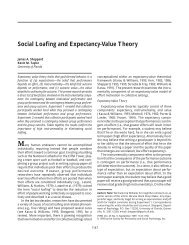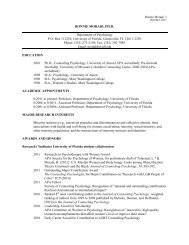Personality theories of successful aging - University of Florida ...
Personality theories of successful aging - University of Florida ...
Personality theories of successful aging - University of Florida ...
You also want an ePaper? Increase the reach of your titles
YUMPU automatically turns print PDFs into web optimized ePapers that Google loves.
<strong>Personality</strong> Theories <strong>of</strong> Successful Aging 89<br />
ensen/ 1996; P. B. Baltes,<br />
Labouvie-Vief, 1981). At<br />
repted set <strong>of</strong> criteria that<br />
laborated by Freund and<br />
lstions regard i ng cri teria<br />
<strong>aging</strong> in particular. P. B.<br />
:cessful <strong>aging</strong> longevity,<br />
:ial competence, procluc-<br />
Similarly, Lawton (1983)<br />
>jective satisfaction with<br />
tppiness or goal achievenotor<br />
behavior, and cogt<br />
as financial or living<br />
ortcomings <strong>of</strong> such lists,<br />
ld be combined, whether<br />
other, and whether the<br />
:ollection to which criteted.<br />
res to defining <strong>successful</strong><br />
characteristics constitut-<br />
; the guiding question <strong>of</strong><br />
(2) process-oriented ap-<br />
:he question What are the<br />
r time? These approaches<br />
sly adapting to changing<br />
rments to fit their needs,<br />
Busch-Rossnagel, 1981).<br />
reeds and capabilities on<br />
:onstraints on the other<br />
Lracterization <strong>of</strong> successspecific,<br />
single criterion.<br />
:-criterion approach that<br />
re only criterion for suc-<br />
'herefore, to understand<br />
in ernpirical studies it is<br />
there is no single def ining<br />
is seen as indicating<br />
d ages well (Neugarten,<br />
rishes between "broad"<br />
mber <strong>of</strong> defining facets.<br />
ng (e.9., Lawton, 7975).<br />
esses the importance <strong>of</strong><br />
tl functioninS;. Her contce,<br />
environmental maspersonal<br />
growth, and<br />
nguish between two dirn<br />
(life satisfaction) and<br />
an emotional dimension (encompassing positive and negative affect; Bradburn,<br />
1969; Campbell, Converse, & Rodgers, 1976; Diener, 1984; Veenhoven, 1991).<br />
These dimensions can be either used in a domain-general way or applied to specific<br />
life domains.<br />
One <strong>of</strong> the critiques <strong>of</strong> subjective well-being as the main or even sole criterion<br />
for <strong>successful</strong> development is that it does not explicitly take environmental conditions<br />
into consideration that support <strong>successful</strong> <strong>aging</strong> or the <strong>successful</strong> interaction<br />
between a person and his or her life context (Havighurst, 1963; Lawton,<br />
1989). A multiple-criteria approach, in contrast, aims at an integration <strong>of</strong> subjective<br />
indicators (e.g., personal life satisfaction and happiness) and more objective<br />
indicators (e.g., everyday instrumental competence). These criteria can be either<br />
short term (e.g., last week's happiness) or long term (e.9., meaning and purpose<br />
in life), domain-specific (e.g., satisfaction with financial situation) or general<br />
(e.g., overall life satisfaction), as well as static and with a definite end point (e.g.,<br />
life satisfaction at a given point in time) or dynamic (e.g., change in life satisfaction<br />
over time; Freund & Riediger, 2003).<br />
Taken together, we distinguish four main approaches to conceptualizing <strong>successful</strong><br />
development and <strong>aging</strong>: criteria-oriented, process-oriented, single-criterion, and<br />
multi-criteria approaches. Table 4.1 summarizes these four outlined approaches.<br />
As we pointed out, there is currently no agreement as to which single criterion<br />
or combination <strong>of</strong> criteria best defines <strong>successful</strong> development. One <strong>of</strong> the reasons<br />
for this lack <strong>of</strong> consensus is that there is no generally agreed-upon model <strong>of</strong><br />
<strong>successful</strong> development and <strong>aging</strong> that could serve as the basis for such a definition.<br />
Instead, there are numerous theoretical approaches to <strong>successful</strong> development<br />
and even more empirical findings pertaining to more or less specific factors<br />
contributing to adaptive development. Integration <strong>of</strong> these findings is difficult<br />
because studies use different indicators for <strong>successful</strong> <strong>aging</strong>.<br />
It is beyond the scope <strong>of</strong> this chapter to <strong>of</strong>fer a comprehensive, integrative<br />
model <strong>of</strong> <strong>successful</strong> development. Instead, we aim at approaching the topic<br />
<strong>of</strong> <strong>successful</strong> <strong>aging</strong> on different levels <strong>of</strong> personality, focusing on the level <strong>of</strong><br />
personal goals and taking different criteria and dimensions into account.<br />
Approach<br />
Table 4.1<br />
Approaches to Conceptualizing Successf ul Development and Aging<br />
Aim <strong>of</strong> Approach (Leading Question)<br />
Criteria-oriented Description <strong>of</strong> characteristics constituting success as an outcome<br />
<strong>of</strong> development ("What ls successf ul development?")<br />
Process-oriented Persoective on individuals as in continuous interaction with their<br />
environment ("What are the processes and conditions that foster<br />
developmental success over time?")<br />
Multiple criteria<br />
Single criterion<br />
Integration <strong>of</strong> subjective and objective indicators ("How can<br />
subjective and objective indicators be integrated into one index <strong>of</strong><br />
successf u I development?")<br />
Assessment <strong>of</strong> a person's global or domain-specific subjective wellbeing<br />
("How can subjective well-being as one indicator <strong>of</strong> <strong>successful</strong><br />
development be assessed [general or domain-specif ic, once or<br />
repeated lyl?")


